- Why we should look after the primary teeth of children
- Early childhood caries (ECC)
- Looking after primary teeth
- Timing of the first dental visit
- Key points
Why we should look after the primary teeth of children
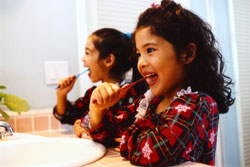
Primary teeth:
- Allow the child to maintain good nutrition and digestion by being able to chew properly;
- Aare important in speech development – if a child has missing teeth, especially the ones at the front of the mouth, the child may encounter difficulties talking when they get older, and this will resultantly require management;
- Are needed for the permanent tooth to form;
- Aid the permanent teeth by saving space for them and “guiding” them into their correct position; and
- Create a healthy smile that can help children feel good about the way they look to others.
Early childhood caries
What is early childhood caries?
The most common chronic disease of childhood is early childhood caries (aka nursing bottle decay, or baby bottle decay). Early childhood caries is the presence of one or more primary teeth with tooth decay, or missing or filled tooth surfaces due to tooth decay in a child aged less than 3 years of age. Early childhood decay is completely preventable if proper dental hygiene is maintained well.
The cause of early childhood caries and how they develop
Early childhood caries can develop as soon as the primary teeth erupt. Decay may be visible to the dentist as early as 10 months of age. Usually, the first stage of tooth decay looks like white spots or lines on the front teeth and if your child is not taken to the dentist immediately, these white areas will rapidly break down into yellow-brown spots and the disease will spread to the back teeth, which may eventually look like black holes. All white lines are not tooth decay, but it is a good idea to get the dentist to look at your child if you notice marks on their teeth.
The main bacteria that are involved in all tooth decay (including early childhood caries) is Streptococcus mutans. This bacteria uses sugars and carbohydrates that we eat as a part of a diet as nutrition for its survival. The waste products the bacteria produce is very acidic, and this dissolves a very small amount of the tooth, as well as allows bacteria to enter your tooth, and starts the process of tooth decay. Teeth, bacteria, and sugar, as well as time, control the severity of the disease; if left for a long time in a person who eats a lot of sugar and does not brush properly, decay will progress.
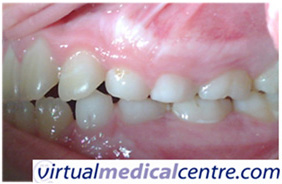 |
 |
|
| Figure 1: Healthy teeth; note the minimal presence of white/yellow spots. | Figure 2: White spots present on the lateral incisor (left circle). These white areas will rapidly break down into yellow-brown cavities (right circle). |
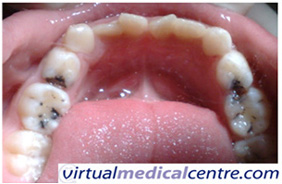 |
| Figure 3: Note decay on molars on both left and right hand sides. |
What increases the chance of a baby getting early childhood caries?
If any of the following apply, they increase the chance of your child getting early childhood caries:
- Teeth that erupt with white, brown, or rough enamel are at greater risk of decay. Defects are more likely in children who are born prematurely or have a low birth weight, and in children of low socioeconomic status.
- If the mum has high levels of the bacteria Streptococcus mutans, the risk of the child getting early childhood caries is more likely, as the mum is able to transfer this bacteria to the child e.g. kissing the child on the mouth, or sharing food and cutlery. Tooth decay at the end of the day is an infection and can be passed from mother to child.
- Parents who smoke may also increase the chance of having a high quantity of the bacteria Streptococcus mutans, and thus will be more likely to transfer the bacteria to their children.
- When we have sugar, it takes about 20 – 40 minutes to stop the negative effects of sugar on the tooth. If someone has a sugary snack every hour, the time for the tooth to recover from the negative effects will be almost non-existent, and the person will have a high chance of getting tooth decay in their mouth i.e. children should not be given sugary snacks throughout the day.
Get on top of your dental health
Find and instantly book affordable dentists within Australia
Severe early childhood caries
The consequences of not treating early childhood caries in an early stage are:
- Severe pain due to infection, pus formation, and eventual death;
- Loss of sleep and inability to focus and learn for the child due to discomfort;
- Inability to eat healthy foods, or foods that the child desires;
- Difficulty talking as the child gets older;
- Loss of space in the arch, and possible crowding that may require orthodontics;
- Higher chance of getting decay in permanent teeth; and/or
- Self-consciousness about smile and appearance, and long-term effects regarding social interactions and self-esteem.
Looking after primary teeth
Determining if your child is at risk
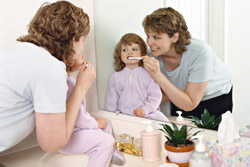
In the first few months of life (0-4 months), the primary teeth are still are not through; however, it is good for the child to be introduced to a dental setting and the dentist can obtain valuable information that can may indicate what sort of risk your child is at of getting tooth decay.
These factors can increase the chance of your baby getting tooth decay:
- Young infants with special health care needs will be at high risk of developing early childhood caries;
- Mothers with high caries rates have a higher chance of passing on decay to their children;
- Families of low socioeconomic status have high caries risk;
- The child’s diet; breastfeeding is the preferred source of infant nutrition. Fruit juice is discouraged because it can cause early childhood caries and has been linked with failure to thrive. Some formulas, especially soy-based formulas that contain sucrose, are also linked with tooth decay in children’s teeth; and
- The sources of systemic fluoride, which in Australia consists mostly of fluoridated tap water; one of the most effective tools in the prevention of dental decay and shown to reduce tooth decay in half for children. Fluoride is essentially good at strengthening teeth against the attack of tooth decay.
How to look after teeth in your baby
Neonate/infant (0-6 months)
It is important to clean your baby’s gums every day before the teeth have even come through into the mouth according the following procedure:
- Cradle your child with one arm: and
- Wrap a moistened gauze square or washcloth around the index finger of the hand of the other arm and gently massage the teeth and gingival tissues; or
- Introduce a soft-bristled toothbrush during this age only if you feel comfortable using the toothbrush, and do not use toothpaste.
Infant/toddler (6-18 months)
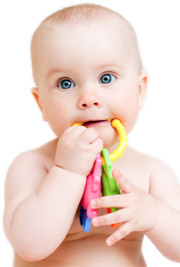
Too much fluoride intake can result in fluorosis; an unattractive mottling of the teeth. Therefore, fluoride intake should be optimal but not excessive. In Australia, if your child is under 18 months of age, toothpastes containing fluoride should not be used.
Toddler/early childhood (18 months – 6 years)
There are special low-fluoride toothpastes with about half the amount of fluoride that have been developed for children and these can be introduced from around the age of 18 months – 6 years. Only a smear of toothpaste (pea-size) should be used and ensure your child spits and does not swallow the toothpaste.
From around the age of 4-5 years, children should begin to learn how to brush their own teeth. These are some of the considerations whilst teaching children how to take care of their teeth:
- Children do not have the manual skills to effectively clean their own teeth properly until around 8 years of age thus, parents should be involved with the brushing till the age of 8-10 years of age;
- Move the toothbrush gently in small circles to clean all surfaces of the teeth. Avoid side-to-side scrubbing, which can damage teeth and gums;
- Electric toothbrushes, which rotate and oscillate can be used, but one with a small brush head should be employed to ensure access to all areas of the mouth;
- In total, you should aim to brush for about two minutes – with patience your child will soon learn to tolerate it; and
- Toothbrushes should also be replaced every 3 months (if used properly).
The Australian Dental Association also advocates that when a child is about two and a half years old, flossing can be done daily and at a minimum, at least twice a week.
Fluoride in the quantity we use it in is very safe; however the risk of giving a toddler fluoride toothpaste is fluorosis. In other countries, and in the past in Australia, parents have given their children supplements or fluoride tablets. These have been found to increase the risk of fluorosis and are no longer recommended in Australia.
If your toddler resists brushing or cannot sit still for two minutes, then try these suggestions:
- Consider a battery-powered brush, which adds novelty to cleaning their teeth
- Sing nursery rhymes or play a favourite song while you help your child brush their teeth
- Offer a reward (ensure that this reward is either non-food or low fat/sugar snacks such e.g. celery or carrot sticks) every time your toddler allows you to brush for two minutes
- Make flossing and brushing as much fun as you can to avoid any negative association or resistance. Talk to your dentist if you need advice.
It is also important to set a good example for your children. Children tend to imitate their parents’ behaviours, and if oral hygiene and dental care are important to you, a child is more likely to take care of their teeth. Visit your dentist regularly to maintain your own oral health which will in turn benefit your child.
Timing of the first dental visit
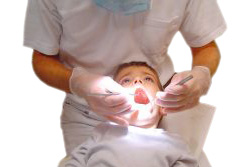
Early dental checkups can provide an opportunity to give oral health education for parents in areas such as:
- Proper dental hygiene;
- Prevention of dental injuries; and
- Prevention of early childhood caries.
Such visits at an early age may also allow children to become comfortable in the dentist’s office.
Key points
- Once the baby or primary teeth start to appear, it is recommended that parents use a baby’s toothbrush with a small head and soft, rounded bristles.
- Up to the age of 18 months the teeth should be brushed with plain water and preferably, teeth should be brushed twice a day – morning and evening.
- There are special low-fluoride toothpastes that have been developed for children and these can be introduced from around the age of 18 months.
- Store all toothpastes out of your child’s reach. Some small children love the taste of toothpaste and will eat it if given the chance.
- Most children should be brushing their own teeth with parental supervision, from eight years of age. By age 10, children should be able to brush their own teeth without the need for ongoing supervision.
- When your child is about two and a half years old, flossing can be done daily and at a minimum, at least twice a week.
- Set a good example as a parent or guardian and look after your own teeth.
Kindly written by Dr Akhil Chandra BDSc. (Hons UWA)
Dentist, Whitfords Dental Centre and Editorial Advisory Board Member of the Virtual Dental Centre
More information
 |
For more information on dental health and hygiene in children aged 0 to 5 years, see Dental Health in Kids. |
References
- Cameron A, Widmar R. Handbook of Paediatric Dentistry. London: Mosby; 1997. [Book]
- For the dental patient. Tooth eruption: The primary teeth. J Am Dent Assoc. 2005;136(11):1619. [Full text]
- Crippen DJ. Frequently asked questions: Why are primary teeth (baby teeth) important? [online]. Sacramento, CA: Capital Pediatric Dentistry; 3 September 2009 [cited 20 October 2009]. Available from: URL link
- Proffit W. Contemporary Orthodontics (3rd editon). St Louis: Mosby; 2000. [Book]
- Edelstein BL, Douglass CW. Dispelling the myth that 50 percent of U.S. schoolchildren have never had a cavity. Public Health Rep. 1995;110(5):522-33. [Abstract | Full text]
- Definition of early childhood caries (ECC) [online]. Chicago, IL: American Academy of Pediatric Dentistry; 2005 [cited 13 August 2007]. Available from: URL link
- Douglass JM, Douglass AB, Silk HJ. A practical guide to infant oral health. Am Fam Physician. 2004;70(11):2113-20. [Abstract | Full text]
- Oral health risk assessment training for pediatricians and other child health professionals. Elk Grove Village, IL: American Academy of Pediatrics; 2005 [cited 13 August 2007]. Available from: URL link
- Douglass JM, Tinanoff N, Tang JM, Altman DS. Dental caries patterns and oral health behaviors in Arizona infants and toddlers. Community Dent Oral Epidemiol. 2001;29(1):14-22. [Abstract]
- Therapeutic Guidelines: Oral and Dental (1st edition). North Melbourne: Therapeutic Guidelines Limited; 2007. [Book]
- Seow WK. Biological mechanisms of early childhood caries. Community Dent Oral Epidemiol. 1998;26(1 Suppl):8-27. [Abstract]
- Seow WK. Enamel hypoplasia in the primary dentition: a review. ASDC J Dent Child. 1991;58(6):441-52. [Abstract]
- Köhler B, Bratthall D. Intrafamilial levels of Streptococcus mutans and some aspects of the bacterial transmission. Scand J Dent Res. 1978;86(1):35-42. [Abstract]
- Aligne CA, Moss ME, Auinger P, Weitzman M. Association of pediatric dental caries with passive smoking. JAMA. 2003;289(10):1258-64. [Abstract | Full text]
- Rugg-Gunn A. Diet and dental caries. In: Murray JJ (ed). The Prevention of Oral Disease (3rd edition). New York: Oxford University Press; 1996. [Book]
- López NJ, Smith PC, Gutierrez J. Periodontal therapy may reduce the risk of preterm low birth weight in women with periodontal disease: a randomized controlled trial. J Periodontol. 2002;73(8):911-24. [Abstract]
- Köhler B, Andréen I. Influence of caries-preventive measures in mothers on cariogenic bacteria and caries experience in their children. Arch Oral Biol. 1994;39(10):907-11. [Abstract]
- Hale KJ. Oral health risk assessment timing and establishment of the dental home. Pediatrics. 2003;111(5 Pt 1):1113-6. [Abstract | Full text]
- Dennison BA. Fruit juice consumption by infants and children: a review. J Am Coll Nutr. 1996;15(5 Suppl):4-11S. [Abstract]
- Erickson PR, McClintock KL, Green N, LaFleur J. Estimation of the caries-related risk associated with infant formulas. Pediatr Dent. 1998;20(7):395-403. [Abstract]
- Tinanoff N, Douglass JM. Clinical decision-making for caries management in primary teeth. J Dent Educ. 2001;65(10):1133-42. [Abstract | Full text]
- Sanchez OM, Childers NK. Anticipatory guidance in infant oral health: rationale and recommendations. Am Fam Physician. 2000;61(1):115-20. [Abstract | Full text]
- Oral hygiene for babies and toddlers [Brochure]. Australian Dental Association; 2009.
- Pendrys DG. Risk of enamel fluorosis in nonfluoridated and optimally fluoridated populations: considerations for the dental professional. J Am Dent Assoc. 2000;131(6):746-55. [Abstract | Full text]
- Daly CG, Chapple CC, Cameron AC. Effect of toothbrush wear on plaque control. J Clin Periodontol. 1996;23(1):45-9. [Abstract]
- Nowak AJ, Casamassimo PS, McTigue DJ. Prevention of dental disease from nine months in utero to eruption of the first tooth. J Am Soc Prev Dent. 1976;6(5):6-12. [Abstract]
- Your child’s first dental visit [Brochure]. Australian Dental Association; 2008.
- Oral health policies. American Academy of Pediatric Dentistry. Pediatr Dent 1999;21:18-37. [Abstract]
- Crall JJ. Prevention of oral disease in children: concepts and practices. Pediatr Ann. 1985;14(2):140-1. [Abstract]
Related diseases
All content and media on the HealthEngine Blog is created and published online for informational purposes only. It is not intended to be a substitute for professional medical advice and should not be relied on as health or personal advice. Always seek the guidance of your doctor or other qualified health professional with any questions you may have regarding your health or a medical condition. Never disregard the advice of a medical professional, or delay in seeking it because of something you have read on this Website. If you think you may have a medical emergency, call your doctor, go to the nearest hospital emergency department, or call the emergency services immediately.







